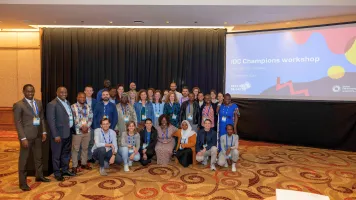This piece is part of a Global Disability Summit blog series from Inclusive Data Charter Champions.
Based on data on displacement and disability prevalence estimates, in 2020, around 12 million forcibly displaced people globally were persons with disabilities. Some types of migration – such as forced displacement – can actually create or worsen existing disabilities. As a result, disability rates for migrants can be much higher in some settings than the 15% global average.
Yet there is no official global data on disability within persons on the move.
This severely limits our understanding of the situation of this group, and means we don’t have enough detail to make much-needed policy changes. Despite important developments such as the World Report on Disability, the IASC Guidelines on Inclusion of Persons with Disabilities in Humanitarian Action, and the proclamation of the 2030 Agenda to ‘leave no one behind’, today we still do not know enough about migrants with disabilities.
Disability and migration: the state of data
When a migrant or forcibly displaced person has a disability, they may face increased vulnerability across areas of their life. This may impact anything from employment to school attendance or sexual safety.
Some subgroups, such as older migrants, may be particularly vulnerable. These can have specific needs related to compounded vulnerabilities. For example, the UNHCR-HelpAge International report 'A claim to dignity: Ageing on the move' shows how migration and disability linked to older age interact in Latin America.
In particular, forced displacement increases individual vulnerability through exposure to violence and injury. It also often worsens existing disabilities, increasing the risk of compounded injury or additional barriers to access services and participate in society. Forced displacement can lead to higher numbers of people with a disability. For example, one study found that over eight years of forced displacement in Syria, 25% of people over the age of 12 have a disability.
Yet, information on migration and disability is limited. Relevant data is often simply not collected. When it is, methods are not standardized which makes comparing data within or across countries difficult. How disability is defined also poses a challenge when trying to compare data – criteria for defining disability for data collection purposes differ across organisations and countries.
Data is needed on both the prevalence of migrants’ disabilities and barriers and risks they face. Prevalence can be complex to compute, and the Washington Group questions have been progressively used to assess this. Data on barriers includes information on physical, attitudinal and communication barriers faced by persons with functional disabilities.
This data is critical. Data allows policymakers to better understand and address migrants’ needs, target interventions efficiently and integrate protection concerns into programming. For example, data is needed to build the right number of accessible latrines in camp or camp-like settings for internally displaced people (IDPs). If needs like this are not included in analysis, they cannot be included in programming.
Emerging practices
So, what can be done? Several innovative projects and practices can help us shape ways forward. For example:
- Leverage specialised tools and resources. IOM’s Displacement Tracking Matrix (DTM), UNHCR, UNICEF, Humanity and Inclusion, and Oxfam teamed together to develop data collection toolkits. The 'DTM Partners Toolkit: Field Companion for Disability Inclusion' provides guidelines on how to collect data on barriers and risks persons with disabilities face in humanitarian emergencies with high mobility. This includes questions that can be used widely and are structured along different functional barriers, exploring how someone’s different abilities in seeing, walking and communicating affects, for example, how they interact with health services.
- Where information is scarce, combine data from different sources. For example, an innovative scoping exercise to explore mobility and disability in South Africa used different types of data, including photos by journalists and conversations with migrants with disabilities.
- Manage datasets with gender, age and/or disability status disaggregation in a safe and ethical way, so the identity of the affected people can be protected.
- Disaggregate data correctly. Many actors involved in migrant service provision do not disaggregate their data by disability status, and those involved in services for people with disabilities often do not disaggregate their data by migratory status. We need disaggregation to understand numbers and characteristics of migrants with disabilities.
- Leverage available datasets on mobility and disability for analysis and policy use. For example, almost 500 datasets on OCHA’s Humanitarian Data Exchange (HDX), an open humanitarian data platform, include some detail on the disability status of populations affected by crisis.
- Involve persons with disabilities in data collection exercises. In addition to being part of “walking the talk” on promoting inclusion of persons with disabilities, ensuring they are involved in data collection and dissemination also increases the chances of capturing nuances related to persons with disabilities and migration, increased trust with respondents and possibly improvement in communication for those with such difficulties.
Better access to basic services, less discrimination and more opportunities can only happen with more information. Better data on migrants with disabilities is fundamental to their full and equal participation in society.
This has been a neglected area of work in the data field to date. IOM is committed to helping address this critical topic moving forward, sparking more discussion and action on addressing the remaining challenges to improving disability-inclusive data on migration.
This is a shortened version of a recent International Organization for Migration (IOM) Global Migration Data Analysis Centre (GMDAC) blog post. This summarises a webinar GMDAC hosted on migration and disability data in December 2021, in celebration of International Day of Persons with Disabilities.


